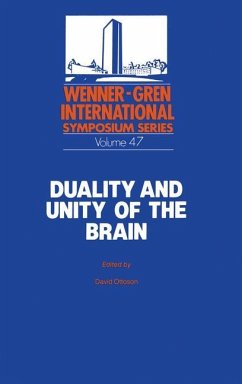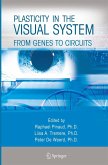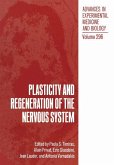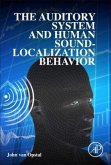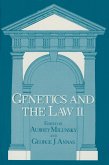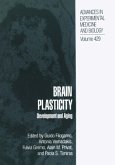David Ottoson
Duality and Unity of the Brain
Unified Functioning and Specialisation of the Hemispheres Proceedings of an International Symposium held at The Wenner-Gren Center, Stockholm, May 29 - 31, 1986
David Ottoson
Duality and Unity of the Brain
Unified Functioning and Specialisation of the Hemispheres Proceedings of an International Symposium held at The Wenner-Gren Center, Stockholm, May 29 - 31, 1986
- Broschiertes Buch
Andere Kunden interessierten sich auch für
![Plasticity in the Visual System Plasticity in the Visual System]() Plasticity in the Visual System112,99 €
Plasticity in the Visual System112,99 €![Perspectives in Ethology Perspectives in Ethology]() P. P. G. BatesonPerspectives in Ethology38,99 €
P. P. G. BatesonPerspectives in Ethology38,99 €![Plasticity and Regeneration of the Nervous System Plasticity and Regeneration of the Nervous System]() Plasticity and Regeneration of the Nervous System77,99 €
Plasticity and Regeneration of the Nervous System77,99 €![The Auditory System and Human Sound-Localization Behavior The Auditory System and Human Sound-Localization Behavior]() John van OpstalThe Auditory System and Human Sound-Localization Behavior71,99 €
John van OpstalThe Auditory System and Human Sound-Localization Behavior71,99 €![Genetics and the Law II Genetics and the Law II]() MilunskyGenetics and the Law II39,99 €
MilunskyGenetics and the Law II39,99 €![Brain Plasticity Brain Plasticity]() Brain Plasticity149,99 €
Brain Plasticity149,99 €![Excitatory Amino Acids and Neuronal Plasticity Excitatory Amino Acids and Neuronal Plasticity]() Excitatory Amino Acids and Neuronal Plasticity77,99 €
Excitatory Amino Acids and Neuronal Plasticity77,99 €-
-
-
Produktdetails
- Wenner-Gren Center International Symposium Series 47
- Verlag: Springer / Springer US / Springer, Berlin
- Artikelnr. des Verlages: 978-1-4612-9081-0
- Softcover reprint of the original 1st ed. 1987
- Seitenzahl: 516
- Erscheinungstermin: 14. Juni 2012
- Englisch
- Abmessung: 235mm x 155mm x 28mm
- Gewicht: 774g
- ISBN-13: 9781461290810
- ISBN-10: 1461290813
- Artikelnr.: 39680151
- Herstellerkennzeichnung
- Springer-Verlag GmbH
- Tiergartenstr. 17
- 69121 Heidelberg
- ProductSafety@springernature.com
Session I Neuroanatomical and Neurochemical Asymmetries of the Brain.- 1. Functional and Neurochemical Asymmetry in the Corpus Striatum.- 2. Laterality in the Neuroendocrine System.- 3. Mechanisms of Brain Asymmetry: New Evidence and Hypotheses.- 4. Asymmetry in the Cerebral Cortex: Development, Estrogen Receptors, Neuron/Glial Ratios, Immune Deficiency and Enrichment/ Overcrowding.- Session II Handedness and Hemispheric Specialization.- 5. Handedness and Cerebral Organization: Data from Clinical and Normal Populations.- 6. Diversities in Right-handers in Left-hemisphere Processing.- 7. Normal Variation in Human Brain Organization: Relation to Handedness, Sex and Cognitive Abilities.- 8. The Evolution of Handedness in Primates.- 9. Spontaneous Drawing in an Unselected Sample of Patients with Unilateral Cerebral Damage.- 10. Extreme Mathematical Talent: A Hormonally Induced Ability?.- Session III Emotion, Attention and Arousal.- 11. Disorders of Emotional Behaviour and of Autonomic Arousal Resulting from Unilateral Brain Damage.- 12. Hemisphere Specialization: A Mechanism for Unifying Anterior and Posterior Brain Regions.- 13. Hemispheric Asymmetry and Positive-Negative Affect.- 14. Variations in Arousal Asymmetry: Implications for Face Processing.- 15. Lateralization of Associative Processes: Human Conditioning Studies.- 16. Laterality and Unconscious Processes.- Session IV Language and Hemispheric Specialization.- 17. Hemispheric Monitoring.- 18. The Intrahemispheric Localization and Some Electrophysiological Correlates of Language and Memory.- 19. Single Neuron Activity in the Right and Left Human Temporal Lobe During Listening and Speaking.- 20. CT Scan Lesions and Language Behavior in Left-handed Aphasia Cases: Observation of Separate Hemispheric Dominances for Handedness, Speech Output and/or Comprehension.- 21. Lateralization of Language in Children with Developmental Dyslexia: A Critical Review of Visual Half-field Studies.- Session V Integration of Hemispheric Functions.- 22. Role of Callosal Connections in the Representation of the Visual Field in the Primary Visual Cortex of the Cat.- 23. Reversed Brain Anatomical Asymmetries in Schizophrenia: A Search for Contributing Variables.- 24. Subcortical Influences on Cortical Processing in 'Split' Brains.- 25. Specificity and Plasticity in Interhemispheric Integration: Evidence from Callosal Agenesis.- 26. Hemispheric Functions Evaluated by Measurements of the Regional Cerebral Blood Flow.- 27. Interhemispheric Interaction: Models, Paradigms and Recent Findings.- 28. Neuroanatomical Aspects of Hemisphere Specialization in Humans.
Session I Neuroanatomical and Neurochemical Asymmetries of the Brain.- 1. Functional and Neurochemical Asymmetry in the Corpus Striatum.- 2. Laterality in the Neuroendocrine System.- 3. Mechanisms of Brain Asymmetry: New Evidence and Hypotheses.- 4. Asymmetry in the Cerebral Cortex: Development, Estrogen Receptors, Neuron/Glial Ratios, Immune Deficiency and Enrichment/ Overcrowding.- Session II Handedness and Hemispheric Specialization.- 5. Handedness and Cerebral Organization: Data from Clinical and Normal Populations.- 6. Diversities in Right-handers in Left-hemisphere Processing.- 7. Normal Variation in Human Brain Organization: Relation to Handedness, Sex and Cognitive Abilities.- 8. The Evolution of Handedness in Primates.- 9. Spontaneous Drawing in an Unselected Sample of Patients with Unilateral Cerebral Damage.- 10. Extreme Mathematical Talent: A Hormonally Induced Ability?.- Session III Emotion, Attention and Arousal.- 11. Disorders of Emotional Behaviour and of Autonomic Arousal Resulting from Unilateral Brain Damage.- 12. Hemisphere Specialization: A Mechanism for Unifying Anterior and Posterior Brain Regions.- 13. Hemispheric Asymmetry and Positive-Negative Affect.- 14. Variations in Arousal Asymmetry: Implications for Face Processing.- 15. Lateralization of Associative Processes: Human Conditioning Studies.- 16. Laterality and Unconscious Processes.- Session IV Language and Hemispheric Specialization.- 17. Hemispheric Monitoring.- 18. The Intrahemispheric Localization and Some Electrophysiological Correlates of Language and Memory.- 19. Single Neuron Activity in the Right and Left Human Temporal Lobe During Listening and Speaking.- 20. CT Scan Lesions and Language Behavior in Left-handed Aphasia Cases: Observation of Separate Hemispheric Dominances for Handedness, Speech Output and/or Comprehension.- 21. Lateralization of Language in Children with Developmental Dyslexia: A Critical Review of Visual Half-field Studies.- Session V Integration of Hemispheric Functions.- 22. Role of Callosal Connections in the Representation of the Visual Field in the Primary Visual Cortex of the Cat.- 23. Reversed Brain Anatomical Asymmetries in Schizophrenia: A Search for Contributing Variables.- 24. Subcortical Influences on Cortical Processing in 'Split' Brains.- 25. Specificity and Plasticity in Interhemispheric Integration: Evidence from Callosal Agenesis.- 26. Hemispheric Functions Evaluated by Measurements of the Regional Cerebral Blood Flow.- 27. Interhemispheric Interaction: Models, Paradigms and Recent Findings.- 28. Neuroanatomical Aspects of Hemisphere Specialization in Humans.

